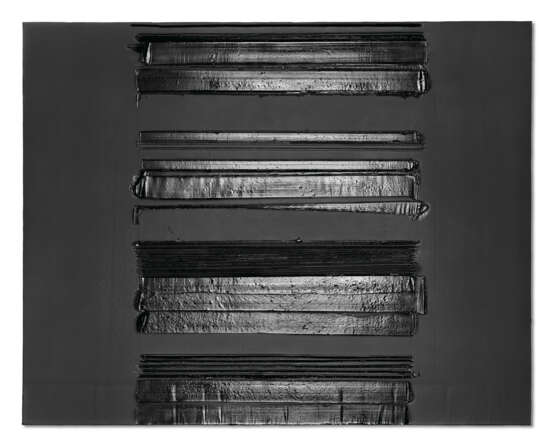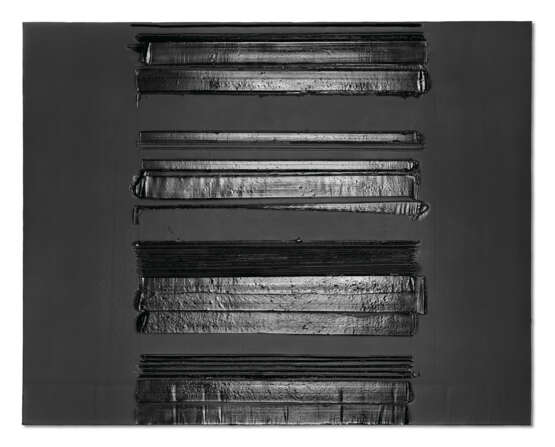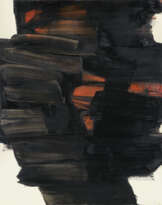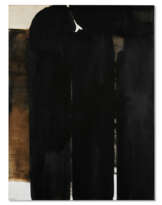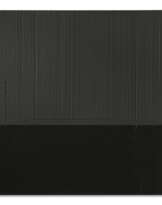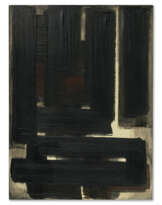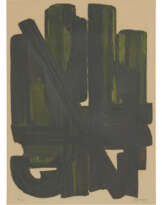ID 832042
Lot 17 | Pierre Soulages (né en 1919)
Estimate value
€ 1 000 000 – 1 500 000
Peinture 175 x 222 cm, 20 juillet 2020
signé, daté et inscrit 'SOULAGES Peinture 175 x 222 cm. 20.07.2020' (au revers)
acrylique sur toile
175 x 222 cm.
Peint en 2020
signed, dated and inscribed 'SOULAGES Peinture 175 x 222 cm. 20.07.2020' (on the reverse)
acrylic on canvas
68 7/8 x 87 3/8 in.
Painted in 2020
Provenance
L'artiste.
Lévy Gorvy, New York.
Collection particulière.
Exhibited
Palm Beach, Lévy Gorvy, Pierre Soulages: Twenty Twenty-One, avril-mai 2020.
Special notice
Artist's Resale Right ("droit de Suite").
If the Artist's Resale Right Regulations 2006 apply to this lot, the buyer also agrees to pay us an amount equal to the resale royalty provided for in those Regulations, and we undertake to the buyer to pay such amount to the artist's collection agent.
ƒ: In addition to the regular Buyer’s premium, a commission of 5.5%
inclusive of VAT of the hammer price will be charged to the buyer.
It will be refunded to the Buyer upon proof of export of the lot
outside the European Union within the legal time limit.
(Please refer to section VAT refunds)
This item will be transferred to an offsite warehouse after the sale. Please refer to department for information about storage charges and collection
details.
Post lot text
« Je trouve fascinant que les hommes soient descendus dans les endroits les plus sombres, dans le noir total de la grotte, pour y peindre avec… du noir. La couleur noire est une couleur d’origine. Et aussi de notre origine. Avant de naître, avant de ‘voir le jour’, nous sommes tous dans le noir ».
Pierre Soulages
Peinture 175 x 222 cm, 20 juillet 2020 donne à voir l’énergie spectaculaire, nerveuse et magistrale, des œuvres ultimes de Pierre Soulages. Se déployant dans la largeur de la toile - dans un format qui rappelle la haute et impressionnante stature du peintre lui-même - les aplats scandent la surface, se superposent, additionnent leurs épaisseurs contre lesquelles la lumière vient s’accrocher, en opposition à l’arrière-plan mat qui absorbe davantage qu’il ne réfléchit. Partout, par ces effets de contrastes et de textures, la lumière semble surgir de l’intérieur même de la toile et module ses infinies variations. Le noir devenu lumière entraîne l’artiste – et avec lui le regardeur – au-delà du noir, dans un territoire étranger, « comme Outre-Rhin ou Outre-Manche désignent un autre pays » (« Le noir, la lumière, la peinture », préface pour A. Mollard-Desfour, Le Dictionnaire des mots et expressions de couleurs, Paris, 2005, p. 14).
Peindre le noir, c’est donc et avant tout pour Soulages peindre la lumière. Enfant déjà, il avait utilisé l’encre noire pour – paradoxalement – peindre la neige sur l’un de ses premiers dessins : « Ce que je voulais sérieusement faire avec mon encre noire, c’était rendre le blanc du papier plus blanc, plus lumineux, comme la neige » (l’artiste cité in Pierre Soulages, Noir lumière : entretiens avec Françoise Jaunin, Lausanne, 2002, p. 51-52). Les premiers outrenoirs sont pourtant le fruit du hasard : un jour de 1979, sans y prêter attention et sans le vouloir vraiment, le peintre laisse le noir envahir l’intégralité de la surface de l’une des toile sur laquelle il travaille alors. À la surprise initiale provoquée par cet accident de parcours, se succédera vite l’exaltation d’avoir fortuitement découvert un nouveau champ d’exploration artistique. Le noir n’allait désormais plus être utilisé en rapport avec d’autres couleurs – principe essentiel des œuvres des décennies précédentes – mais pour lui-même, pour sa matérialité propre et sa façon singulière de réfléchir la lumière. À partir de 2004, le peintre abandonne l’huile pour embrasser l’acrylique, matière qui lui permet davantage encore de sculpter la surface en profondeur et d’imprimer à la pâte épaisse des sillons plus profonds, plus larges et plus intenses. Peinture 175 x 222 cm, 20 juillet 2020 incarne en cela un exemple emblématique de l’aboutissement d’une vie de recherches et de trouvailles fertiles, faisant écho à la quête inlassable résumée par le peintre : « Le noir a des possibilités insoupçonnées et, attentif à ce que j’ignore, je vais à leur rencontre ».
“I find it fascinating that men went down into the darkest places, into the total obscurity of the caves, to paint with... black. Black is a colour of origin. And also of our origins. Before being born, before 'seeing the day', we are all in the dark.”
Pierre Soulages
Painting 175 x 222 cm, 20 July, 2020 gives the possibility of seeing the spectacular, nervous and masterful energy of Pierre Soulages’ ultimate works. Spreading out across the width of the canvas - in a format that recalls the high and impressive stature of the painter himself- his flat areas give rhythm to the surface, overlap, add their thicknesses against which the light clings, in opposition to the matt background that absorbs more than it reflects. Everywhere, through these effects of contrasts and textures, light seems to emerge from within the canvas itself and modulates its infinite variations. Black becomes light and takes the artist - and with him the viewer, beyond the black, into a foreign territory, “as Beyond the Rhine or Beyond the Channel designate another country” (“Le noir, la lumière, la peinture," preface for A. Mollard-Desfour, Le Dictionnaire des mots et expressions de couleurs, Paris, 2005, p. 14).
For Soulages, to paint black entails therefore and above all to paint light. As a child, he had already used black ink to - paradoxically - paint the snow on one of his first drawings: “What I seriously wanted to do with my black ink was to make the white of the paper whiter, brighter, like snow” (the artist quoted in Pierre Soulages, Noir lumière: entretiens avec Françoise Jaunin, Lausanne, 2002, p. 51-52). The first outrenoirs are however the fruit of happenstance: one day in 1979, without paying attention and without really wanting to, the painter allowed black to invade the entire surface of one of the canvases he was working on at the time. To the initial surprise provoked by this accident, of course, quickly succeeded the exaltation to have fortuitously discovered a new field of artistic exploration. Black would no longer be used in relation to other colours - an essential principle of works from previous decades - but for itself, for its own materiality and its singular way of reflecting light. From 2004 onwards, the painter abandoned oil to embrace acrylic, a material that allowed him to sculpt the surface in depth and to print deeper, wider and more intense grooves in the thick paste. Painting 175 x 222 cm, 20 July, 2020 embodies an emblematic example, highlighting the culmination of a lifetime of research and fertile findings, echoing the tireless quest summarized by the painter: “Black has unsuspected possibilities and, attentive to what I do not know, I venture out to meet them.”
| Artist: | Pierre Soulages (1919 - 2022) |
|---|---|
| Art style: | Contemporary art |
| Place of origin: | Western Europe, France, Europe |
| Auction house category: | Paintings |
| Artist: | Pierre Soulages (1919 - 2022) |
|---|---|
| Art style: | Contemporary art |
| Place of origin: | Western Europe, France, Europe |
| Auction house category: | Paintings |
| Address of auction |
CHRISTIE'S 8 King Street, St. James's SW1Y 6QT London United Kingdom | |
|---|---|---|
| Preview |
| |
| Phone | +44 (0)20 7839 9060 | |
| Buyer Premium | see on Website | |
| Conditions of purchase | Conditions of purchase |
